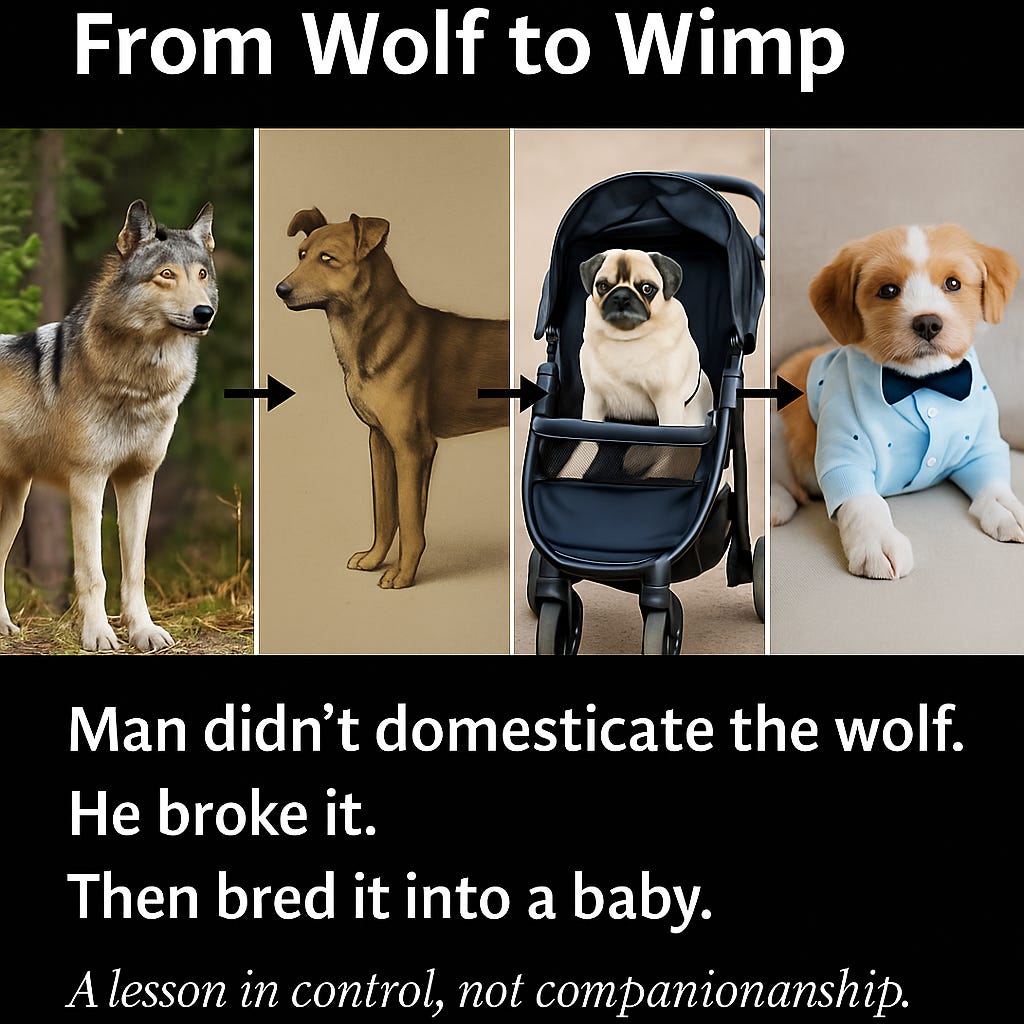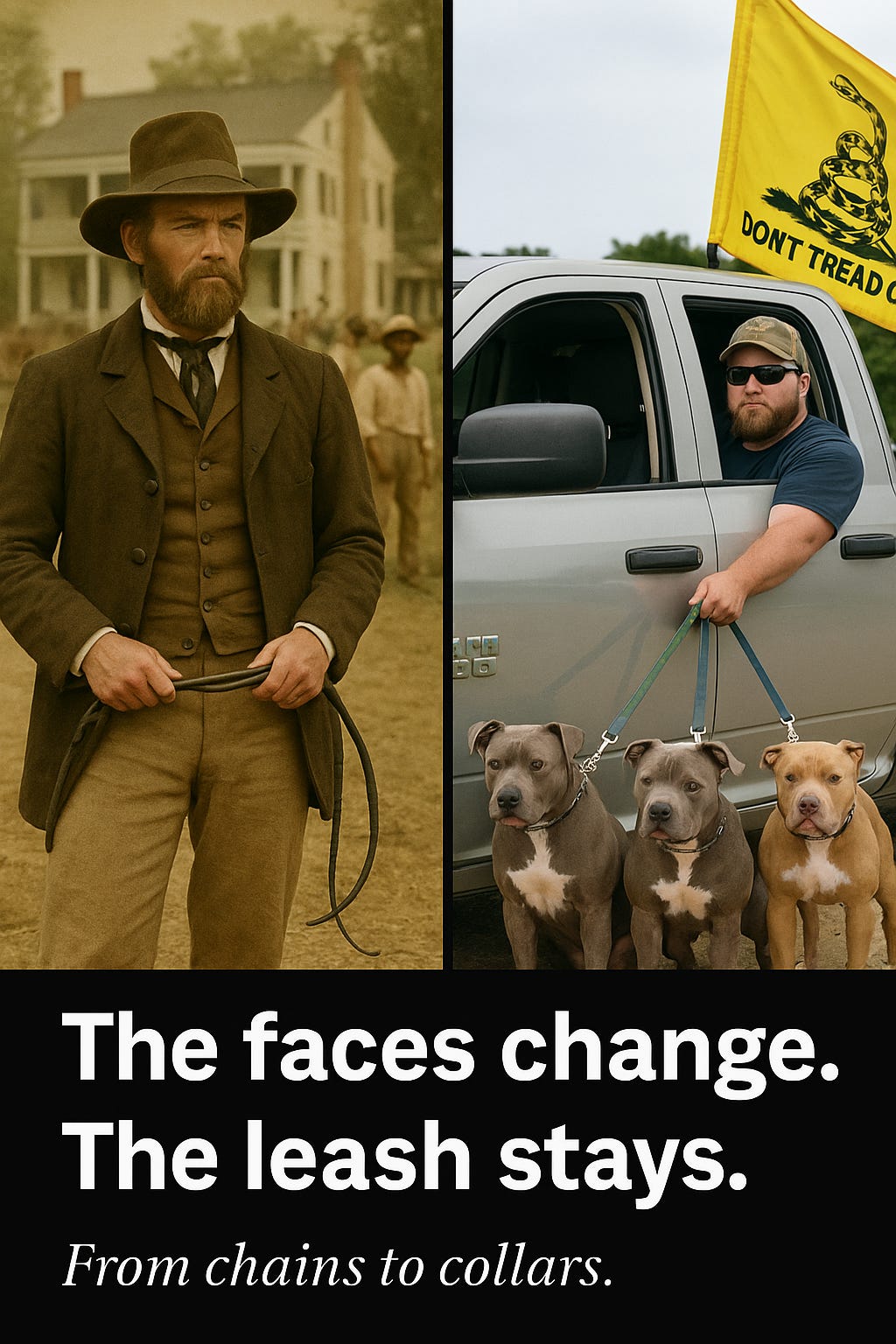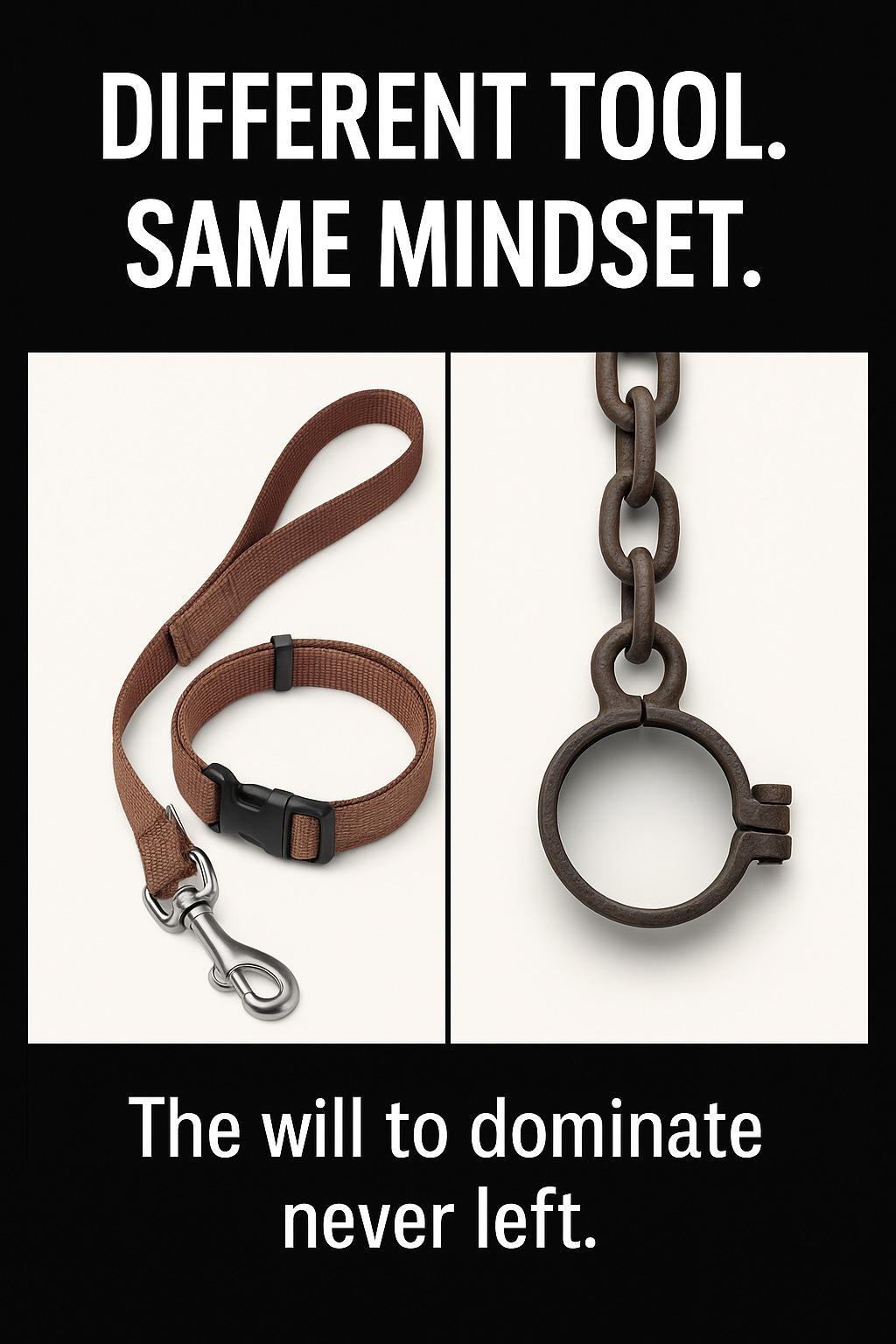From Chains to Leashes: The Southern Fetish for Owning the Living
The Psychology of Ownership
In a country founded on liberty, it's astonishing how deeply the culture of ownership persists—not just over property or capital, but over sentient beings. From human slavery to the domestication and “ownership” of animals, America has long fetishized control. Nowhere is this more apparent than in the Deep South, where the echoes of slave plantations still reverberate through the picket-fenced yards of high dog-ownership households.
The Legacy of Slave States
The Southern United States once legally owned human beings as chattel. The architecture of plantation capitalism demanded strict hierarchy: white over Black, man over woman, master over slave. That system was never fully dismantled—just rebranded. After abolition, systems of control persisted through Jim Crow, prison labor, and economic disenfranchisement. But the psychological framework remained: dominance, hierarchy, and control as cultural values.
Today, states with the highest historical investment in slavery—Mississippi, Alabama, Georgia, South Carolina—rank among the top in dog ownership. It's not mere coincidence. The cultural logic of ownership never disappeared; it adapted. Where humans could no longer be legally owned, animals filled the gap. The dog became a symbol of loyalty, subservience, and property—a living extension of the owner's dominion.
The Theology of Dominion
Much of Southern culture is steeped in fundamentalist Christianity. The Book of Genesis grants mankind “dominion over the animals,” a concept internalized and literalized across generations. Owning a dog is framed not just as a lifestyle choice, but as a fulfillment of Biblical authority.
This religious ethos elevates ownership to a spiritual duty. It's not hard to trace a line from scripture-justified slavery to scripture-justified animal subjugation. The master-slave dynamic simply found new expression through the leash, the kennel, and the electric fence.
Indicators of a Culture of Control
Statistical overlaps reveal the cultural ecosystem of dominion:
Dog ownership is highest in former Confederate states.
These same states also rank highest in child abuse, STD rates, poverty, low educational attainment, and incarceration.
The commonly-called "white trash" demographic—undereducated, rural, conservative, religious whites—embraces dog ownership as both identity and insulation against precarity.
In this culture, the dog functions as a proxy for control: something to train, cage, pet, and punish. Something to be loyal when humans fail. Something that will never question authority.
The Dog as Captured Nature
To own a dog is, in essence, to enslave a piece of nature. Dogs did not exist as they are today in the natural world—they are human-engineered artifacts. The domesticated dog is the product of forcibly altering the wolf, stripping it of its autonomy, its survival instincts, and its ability to evolve freely. Dogs are kept in a state of perpetual infantilization: dependent, obedient, emotionally needy. In this way, man created the dog as an enslaved version of the wolf—a creature of nature broken into a pet.
Owning a dog is not simply a companionship choice; it is a conscious act of capturing nature and rewriting its destiny for human comfort. The dog is frozen at the emotional age of a child, programmed to beg for praise, walk on command, and seek approval. Man didn't just tame the wolf—he lobotomized it over generations, molding it into something loyal yet powerless.
Contrast this with the cat. Cats have been present since ancient Egypt and still retain much of their independence and predatory instincts. A cat can survive without a human. It can hunt, navigate, and adapt. A dog, on the other hand, has been so deeply domesticated that it lacks the tools to survive in the wild. Dogs are not just owned; they are biologically altered to remain in permanent servitude.
And yet, ironically, the modern domesticated cat would likely live far longer if not for humans. While cats retain more autonomy, even they are victims of confinement, malnourishment, and abuse within the pet system. But the critical distinction remains: cats can still remember how to live without us. Dogs cannot.
Global Pet Ownership—America and the World
The United States leads the world in dog ownership, with nearly half of all households owning at least one dog. This is more than just an expression of affection; it reflects a cultural obsession with domestication and control. Countries like Argentina, Mexico, and the Philippines also have high dog ownership rates, often due to looser pet laws, widespread street dog populations, and cultural norms of keeping animals close to the home.
By contrast, many advanced secular nations—particularly in Western Europe—show far lower levels of dog ownership. Switzerland, France, and Denmark hover around 10 to 12 percent of households owning dogs. Singapore, a densely urban and highly regulated city-state, reports similarly low figures. These countries often emphasize ecological balance, urban cleanliness, and responsible breeding over emotional gratification through ownership.
Take Switzerland as a case study: dog ownership is strictly regulated by the state. Prospective owners must complete mandatory training courses and obtain a license. Fines for leaving dog feces in public areas can be extremely high, and repeat offenders may lose their right to own a dog altogether. Ownership in Switzerland is a privilege—not a birthright. It's a model of animal stewardship that views control through the lens of legal and ethical responsibility rather than emotional entitlement.
In the United States, this contrast is further reflected between cities. New York City—the densest and most secular metropolis in the country—has the lowest percentage of dog ownership, with only around 22% of households owning dogs. In stark contrast, suburban and rural areas in the American South and Midwest report the highest dog ownership rates, often exceeding 45%. These geographies reflect not just population density, but divergent worldviews: one leans toward secular modernism, regulation, and collective living; the other, toward individualism, private property, and the normalization of animal control within the household.
Interestingly, the most religious and conservative nations—particularly in the American South and Eastern Europe—demonstrate the highest rates of pet ownership, especially dogs. The pattern holds: more hierarchy, more control, more “ownership” of the living.
Eastern Europe & the Dominion Narrative
The pattern seen in the American South repeats in Eastern Europe. Nations like Hungary and Poland are among the most religious and politically conservative in the EU. They are also at the top of Europe's dog ownership charts.
Hungary
Dog-Owning Households: 50% (highest in Europe)
Religiosity: ~75% Christian (Catholic/Calvinist)
Political Context: Far-right, nationalist government (Orbán)
Poland
Dog-Owning Households: 49%
Religiosity: 72–79% Catholic, high church attendance
Political Context: Catholic-nationalist ruling party (Law & Justice)
This cultural matrix of religiosity, authoritarian politics, and traditionalism fosters a value system centered on ownership, obedience, and loyalty. In such societies, dog ownership is not just common—it is symbolic of a worldview rooted in patriarchal control, nationalism, and the sanctity of human dominion over nature.
Urban Progressive Contrast
Compare this to urban, secular, liberal areas like New York, San Francisco, or Boston. Dog ownership drops dramatically. Dense housing, collective infrastructure, and post-religious ethics challenge the instinct to dominate—but they rarely dismantle it.
Here, the rise of rescue culture, veganism, and ecological consciousness appears to push back against the dominion narrative, but often only repackages it. The language of care replaces the language of control, yet the structure remains: ownership masked as empathy, captivity disguised as sanctuary.
Even in these cities, the leash is not absent—it’s aestheticized. Domination is no longer brute but benevolent. The pet becomes a symbol not of traditional power, but of progressive virtue. But a sentient being, no matter how gently caged, is still caged.
The Chain Remains
Future generations may look back on the widespread practice of pet ownership—especially of animals bred into dependence—as a primitive relic of a less enlightened time. Just as we now view slavery, bloodletting, or child labor with moral horror, the idea of "owning" sentient beings may one day be seen as an archaic extension of our past dominion-based worldviews. What is now seen as affection may later be judged as infantilization, manipulation, and control.
As societies evolve toward empathy, sustainability, and interdependence with nature, the leash may ultimately be recognized not just as a tool of affection, but as a symbol of our species’ unresolved need to dominate what we refuse to understand. The normalization of emotional bondage under the guise of care will likely become a psychological curiosity to future historians—proof of a culture still wrestling with its impulse to possess everything it touches.
Until we dismantle the very idea that living beings can or should be owned, we remain spiritually shackled—our hands gripping leashes that once held chains.




